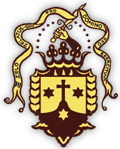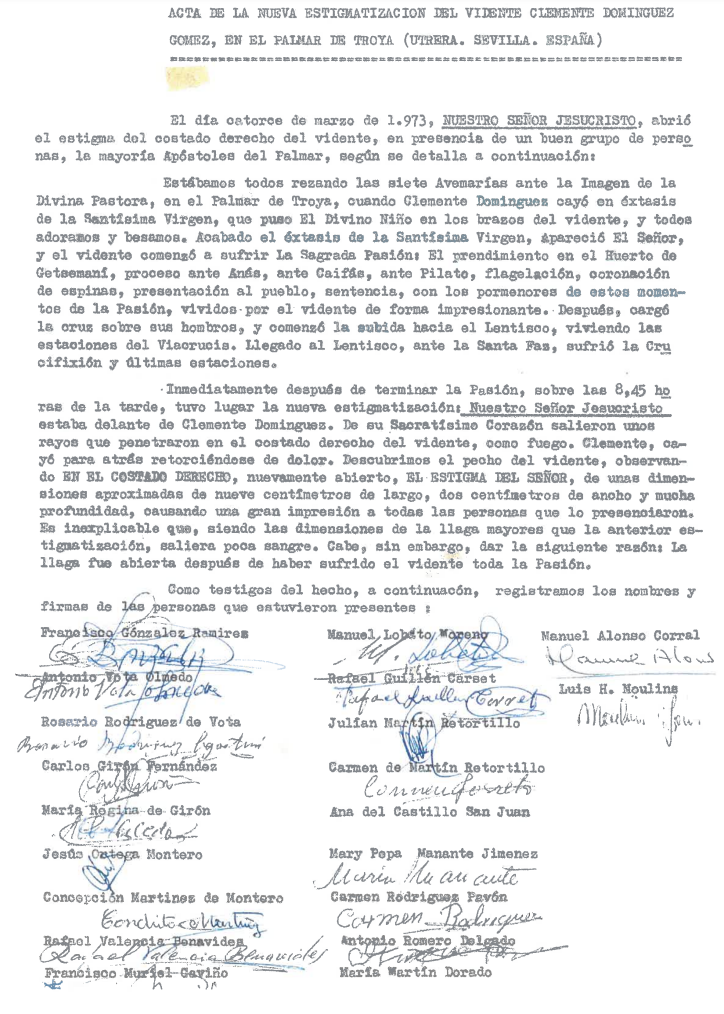Pope Saint Pius XII the Great
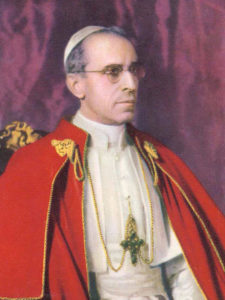
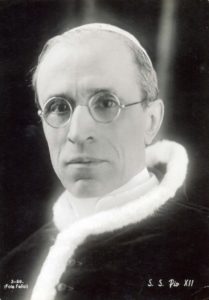
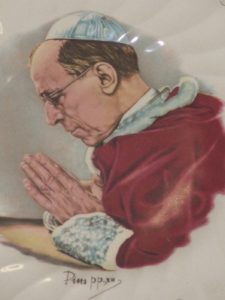
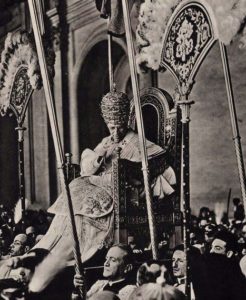








Pope Saint Pius XII the Great, Pastor Angélicus. (2-3-1939 to 9-10-1958)
Doctor. Great Mystic. Stigmatic. Spiritual Martyr. Apostle of Peace.
Born in Rome, Italy. Pontificate: from the 2nd of March 1939 to the 9th of October 1958.
This glorious Pope, in the world Eugene Pacelli, was born into an illustrious family on the 2nd of March 1876. He was ordained Priest in 1899. A person of great qualities and deeply pious, he did his studies in Philosophy, Theology, Civil Law and Canon Law with brilliant results. He was professor in the Gregorian University, and went on to hold a post in the Secretariat of State. In 1917 he was named Archbishop; and that same year was sent as Apostolic Nuncio to Munich, and later to Berlin. In 1929 Saint Pius XI named him Cardinal. The following year he filled the post of Secretary of State. Pope Saint Pius XII won great prestige, including outside the Church, for his wonderful gifts of intelligence, learning, capacity for work, sobriety of life and powerful personality. He stood out in a very special way in the field of doctrine. He endeavoured to have the greatest number of representatives from countries of the five continents in the College of Cardinals. He died in Castelgandolfo, some twenty-five kilometres from Rome, and his remains were solemnly translated to the city.
Pope Saint Pius XII the Great was Exalted Whip against multiple heretics; Vigorous Switch against freemasons, revolutionaries and other satanic ideologists; Renowned Scythe against freemasonry, agnosticism, modernism, socialism, communism, ruthless capitalism, liberalism and other satanic ideologies; Signal Hammer against tyrants; Sure Machete against authors of anti-Catholic books, propagators of obscenity and secularists in government and education, and Firm Staff against sacrilegious and obscene feasts. This glorious Pope never sympathized with Hitler’s accursed nazi ideology nor with Mussolini’s accursed fascist ideology.
This Glorious Pope, in an apostolic decree, condemned communism as a materialistic and anti-Christian doctrine, completely hostile to God, to true Religion and to Christ’s Church. Under pain of excommunication reserved to the Pope, he forbade Catholics to become members of the communist party or to support it, as likewise to publish, spread or read any writings in defence of its vitiated doctrines and activities. Accordingly, he declared to have apostatized from the Catholic Faith: whoever professes the communists’ materialistic and anti-Christian doctrine, and whoever defends and spreads it. He vigorously condemned agnosticism, which denies all capacity of intelligence in man for discerning God’s existence, and likewise condemned modernism.
Pope Saint Pius XII took every pain to avoid the frightful conflagration of World War II, imploring the European powers which had opened up hostilities to settle their differences peacefully, and he proposed means for reaching a settlement, though all in vain. Amid the world catastrophe, the Pope made known his deep fatherly consternation at the ruination and unspeakable sufferings of mankind. By means of peace messages he worked intensely to prevent the war spreading, to reduce its destructive effects, to mitigate inhuman consequences for the conquered peoples and achieve peace. But his voice went unheard. He turned to prayer in an exceptional way, organizing special crusades for world peace, and exhorted rulers to make every effort quickly to secure a worthy peace. The Pope’s charity during World War II was verily heroic, and did not take into account religious, ethnic or national differences. He was chiefly concerned with the wounded and prisoners-of-war, and obtained that their conditions of life become more humane. He mitigated as much as he could deportations and systematic liquidation of civil populations. To help them more effectively, on his recommendation, his Substitute in the Secretariat of State, John Baptist Montini, opened an information office in the Vatican for missing soldiers and located the whereabouts of many of them. Saint Pius XII organized large national collections to be made for the relief of the needs of many, and very specially for those of child victims of the war. During the bombing of Rome in the summer of 1943, Saint Pius XII, making his way over rubble and ruins, lavished every manner of consolation on the victims. Saint Pius XII’s paternal charity towards thousands of the needy was universally acknowledged: repatriations, supplies of food and clothing, stocks of medicines and medical attention for the sick, establishment of camps to take in children, and so forth. Furthermore, he protected a countless number of Jews persecuted by Hitler’s nazis, and a great many were enabled to survive thanks to the Catholic Church’s help. Saint Pius XII, in his addresses, referring to the nazi horrors, condemned the massacres committed because of racialism. Nonetheless, the war over, a campaign was launched, principally communist, to denigrate the Sovereign Pontiff, saying that he had remained impassive in the face of the world’s sufferings. Yet, during World War II the Pope had performed his duty masterfully, without letting himself be influenced by propaganda from either side; and, without interference of any kind, was able to continue governing the Universal Church. The war over, Saint Pius XII addressed a message to the world by radio, calling for the peace to be a true one and founded on concord and justice. The Pope’s activity in support of peace was a factor throughout his Pontificate.
This glorious Pope, by means of transcendent encyclicals, enriched the Church’s doctrinal treasure. In his pertinent documents, he speaks of the Church as the Mystical Body of Christ. In others he ennobles the dignity of the family, which the State should respect, outlines the family’s mission in society, urges prayer in family and lays stress on the duties of marriage. In his addresses and writings, he defended the dignity and rights of the worker, proclaiming that the Church is the upholder of the just aspirations of working people in their varied classes of trades and professions. In his discourse to the Association of Catholic Teachers, he upheld the lofty mission of teachers as delegates and representatives of parents in the education of children. In an address before a large number of the sick, he expounds the immeasurable value of suffering. In his discourses he also referred to industry in its varied facets, to sport, and so forth. He addressed edifying messages to different representations of Catholic men; he gave an impulse to Catholic Missions, instilling the true missionary spirit in Missionaries; he put the utmost interest into the organization of seminaries, into fomenting Priestly vocations and into the solid formation of candidates for the Priesthood. Likewise, he fomented the true spirit of the different religious Orders and Congregations. In an Apostolic Constitution he gave official entry to a new form of consecration to God by way of the approbation of Lay Institutes. He placed great interest in cultivating, among others, apostolic movements of Catholic Action, Marian Congregations and the Apostolate of Prayer. There was scarcely a single religious issue which the Pope did not deal with in his apostolic addresses and writings. Saint Pius XII beatified and raised to the Glory of the Altars a considerable number of the blessed. He proclaimed the Marian Year 1954 in commemoration of the first centenary of the proclamation of the Dogma of Mary’s Immaculate Conception.
Pope Saint Pius XII, in his Apostolic Constitution of the 1st of November 1950, after extolling the unimaginable grandeur of the Mother of God, infallibly proclaimed, declared and defined: “Concluded the course of Her earthly life, the Immaculate Mother of God, the ever-Virgin Mary, was Assumed into Heavenly Glory in Body and Soul.”
On the 27th of August 1953, the Holy See signed a new Concordat with Spain, then ruled by Generalissimo Caudillo Saint Francisco Franco Bahamonde. In this Concordat a series of agreements reached with the Holy See over previous years by the Caudillo’s government was confirmed, and the rights of the Church and the Catholic Religion as the official and sole religion of the Spanish State were recognized in their maximum amplitude. This Concordat has always been considered a model.
Nonetheless, Glorious Pope Saint Pius XII the Great committed great blunders in his pontificate. Without a previous and conscientious study he arbitrarily condemned the Heavenly Apparitions of the sacred place of Heroldsbach in Germany. He withdrew the Apostolic Nuncio from Madrid, thereby yielding to the satanic, masonic orders given by the infamous thirty-third degree freemason, American president Truman, who decreed an international boycott against the Most Christian Spanish regime of Caudillo Saint Francisco Franco Bahamonde. To gratify repeated petitions from many clerical spokesmen of easy-going lay people, he changed the traditional Carmelite Scapular for a medal, which was not pleasing to the Most Holy Virgin Mary, for She made known her complete disagreement in several places of Apparitions.
Canonized by Pope Saint Gregory XVII the Very Great on the 12th of September 1978. Declared Doctor of the Church by the same Pope on the 15th of October 1978.
Pope Saint John XXIII
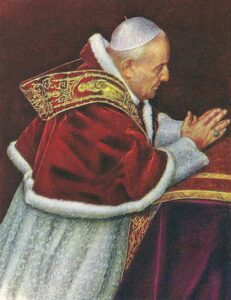
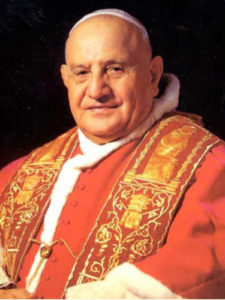
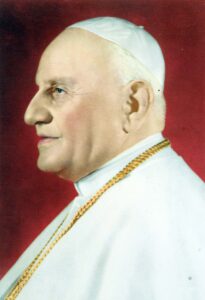
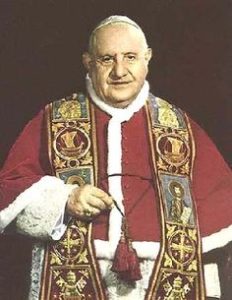
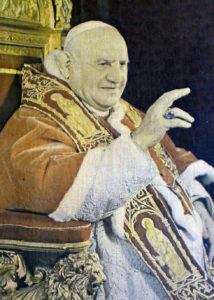
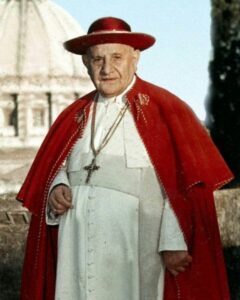








Pope Saint John XXIII, Pastor et Nauta. (28-10-1958 to 3-6-1963)
Palmarian Calendar: Great Mystic. Stigmatic. Spiritual Martyr. Apostle of Marian Devotion.
Born in Sotto il Monte, Bergamo, Italy. Pontificate: from 28th of October 1958 to 3rd of June 1963.
This glorious Pope, in the world Angelo Joseph Roncalli, was born on the 25th of November 1881, into a modest farming family. He did his studies in the Bergamo seminary. On the 10th of August 1904 he was ordained Priest. From 1905 to 1914, he was secretary to the Bishop of Bergamo and a seminary professor. During World War I, he was a military chaplain, and gave proofs of his spirit of self-denial and sacrifice. In 1921, he occupied high office as director of the Congregation for the Propagation of the Faith. In the year 1925 he was consecrated Bishop in Rome. In 1953 he received the Cardinal’s hat and was named Patriarch of Venice. He lived a life of constant prayer and penance. This glorious Pope, owing to his benevolence and simplicity, was utilized by the Church’s enemies.
On setting out by train from Venice to the Conclave which elected him Pope, a white dove settled over the compartment he had entered.
His Malachian motto was “Pastor et nauta”, which fitted him perfectly, being a trusting and understanding person, and Patriarch of Venice.
Saint John XXIII was the author of a very pious autobiographical book: “Journal of a soul”.
We extract the following paragraph from the Pontifical Documents of Pope Saint Gregory XVII on Saint John XXIII: “He had a very special devotion to the Sacred Passion of Our Lord Jesus Christ. This holy Pope was an eminent lover of the Most Precious Blood of the Redeemer, and professed an ardent and filial love for the Most Holy Virgin Mary. Saint John XXIII demonstrated with all clarity his ardent Marian devotion by devoutly reciting every day the fifteen mysteries of the Holy Traditional Rosary, the Angelus and other pious practices in honour of Mary. Saint John XXIII had the pious custom of commending and consecrating himself daily to the Virgin Mary. This holy Pope also professed great love for Most Glorious Saint Joseph. His personal life was that of an irreproachable Priest.” In the Litany of the Saints, it was a decision of his to raise Saint Joseph and place him beside the Virgin, saying: “This is his place.”
Shortly after his Papal election, he visited his elderly mother who, on seeing him, commented that he was all dressed in white. To which he replied: “And you too, mother, are all dressed in white” – for her baptismal innocence.
The Palmarian Creed says: “I believe that the Devil, Lucifer, by divine leave, was unchained during the Pontificate of Pope Saint John XXIII, to further sift and purify the Church.”
The Vatican II conciliabulum was held from 1962 to 1965. The following paragraphs are taken from the Pontifical Documents of Pope Saint Gregory XVII the Very Great: “It was announced that at the end of time an Angel would open up the doors to the devil. True, Saint John XXIII was called Angel Joseph. This Angel did not open the door to do harm to the Church, but believing in the goodness of others, and because he, being good, was unable to see ill-will in others. We come out in defence of the Sacred Person of Pope Saint John XXIII. The mistakes made in governing the Church during his Pontificate cannot be wholly blamed on him; as this holy Pope, owing to his benevolence, was utilized by the Church’s enemies. This Pope was incapable of thinking badly of others. He trusted everyone, believing in the apparent goodness of those around him.”
“Vatican Council II was certainly convoked by Our Revered Predecessor Pope Saint John XXIII, in the face of the terrible events related in the Fatima Secret. The Pope, dismayed at the content of the Fatima Message, felt the inspiration of the Holy Ghost to convoke the Council. In the first sessions of the Council, the Holy Ghost still hovered over the Council hall where the Council Fathers gathered. After the first sessions, the Council hall was a reflection of mankind prior to the Universal Flood. The Holy Ghost withdrew from the Council, just as He had done at mankind’s general prevarication preceding the Universal Flood chastisement, when He withdrew from men. The Holy Ghost, who had withdrawn from the people, entered into Noah’s Ark, to guide that just man. With Vatican Council II and with Pope Saint John XXIII’s optimism, everyone hoped for a wonderful spring in the Church. But the sad reality was that the hoped-for spring turned into the cruellest and stormiest winter that the Church has known… without doubt Pope Saint John XXIII was coerced and manipulated by freemasons.”
The following paragraph on the Vatican II conciliabulum is taken from the ‘Treatise on the Holy Mass’ of the Palmarian Holy Councils: “We repeat, yet more unreservedly, our condemnation of so-called Vatican Council II. Though this Council was convoked by Pope Saint John XXIII inspired by the Holy Ghost, before long, owing to the oppressive influence of a great proportion of masonic and progressivist Council fathers, and owing to the cowardice and human respect of no few traditionalists, the Council’s sound finality became prostituted, and conclusions were reached that were openly erroneous and ambiguous; which evidences that the Holy Ghost had been expelled from the Council halls to give entry therein to Satan. This then is why Vatican Council II, with respect to its unfolding and the decisions made, is not the work of the Holy Ghost, but of the devil. Though in the Council acts there are parts with true teachings, they are mixed up with dreadful heresies and ambiguities; since freemasonry, thus covering up the evil, thereby made it easier for Catholics to accept the Council texts, and for the Church’s enemies to attain their perverse ends more readily. If we examine doctrinal writings of different accursed reformers like Luther, Calvin, and so forth, among heresies and corruption we find in them as well some truths of Faith. This reveals a malicious tactic for the purpose of making the need and lawfulness of those infernal reforms more readily credited. Vatican Council II, because of its documents’ content of heresy, ambiguity and the perverse conclusions to which freemasons and progressivists led it, is unlawful, noxious and abominable, and therefore void of all authority in the Church. By the above we do not stain the illustrious and infallible authority, as likewise the good faith, of Popes Saint John XXIII and Saint Paul VI, who ruled the Church at the time of the Council; for as regards the first of those Pontiffs, John XXIII, his enemies exploited his excessive paternity, kindness and optimism, instead of availing themselves of him for their conversions.”
In the dreadful agony that prepared him to pass over to the other life, he purified in part the mistakes of his Pontificate with terrible sufferings, for at his death he passed momentarily through purgatory.
Canonized by Pope Saint Gregory XVII the Very Great on the 24th of October 1978.
17th of August 1979. A vision described by Pope Saint Gregory XVII: “First the Lord appeared; He was attired as Christ the King, in white tunic and red cape, with Sceptre and Crown. The Most Holy Virgin came, Our Crowned Mother of El Palmar, with Imperial Crown, Royal Mantle. Afterwards Saint Joseph came, also crowned. Saint Peter and Saint Paul, Apostle Saint James, Saint John the Evangelist, Saint Pio IX, Saint Pio XII, Saint John XXIII, Saint Paul VI, Saint Teresa of Jesus, Saint Ignatius of Loyola, Saint Francisco Franco and Saint José Antonio Primo de Rivera; and an incalculable multitude of Angels, clothed in extraordinary attire; and on high the Eternal Father and the Holy Ghost were to be seen.
Pope Saint Paul VI
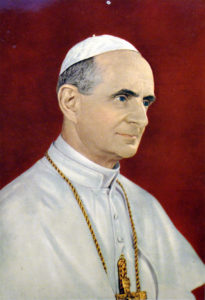
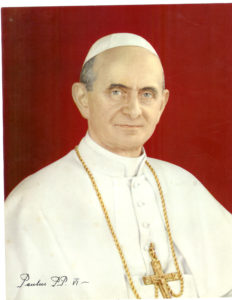
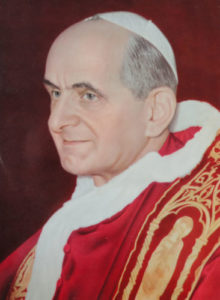
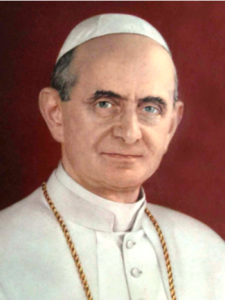
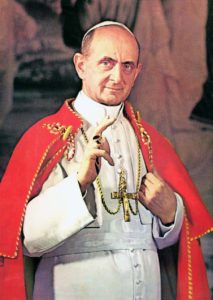








Pope Saint Paul VI, Flos Florum. (19-6-1963 to 6-8-1978)
Palmarian Calendar: Great Mystic, Stigmatic. Great Martyr of the Vatican. Exalted Protector of the Holy Palmarian See.
Born in Concesio, Brescia, Italy. Pontificate: from the 19th of June 1963 to the 6th of August 1978.
This Glorious Pope, in the world John Baptist Montini, was born on the 26th of September 1897. He was ordained Priest in 1920. In 1924 he was appointed to the Vatican Secretariat; and in the year 1937 went on to become Substitute of the Secretariat of State held by Eugene Pacelli. After having exercised different offices for thirty years in the Vatican, he was consecrated Bishop in 1954, and appointed to the diocese of Milan. In 1958 he was named Cardinal. Pope Saint Paul VI’s life was exemplary and virtuous. He lived a life of prayer and penance and, of course, constant sacrifice, his pontificate being a dolorous ascent to Calvary. For the greater part of his pontificate, this Glorious Pope was drugged by villainous members of the Roman Curia with the object of weakening his will and having him at their mercy.
Many are the Heavenly Messages of Palmar (and of other places of Apparitions), more than one hundred from Palmar, which speak of the situation of Pope Saint Paul VI during his Pontificate. They are of the greatest importance and essential to be able to understand his Papacy. Our Lord Jesus Christ thus deigned to assist His Church during those terrible years, clarifying the situation of the persecuted Pope, essential for the faithful to be able to find their bearings in the face of the growing apostasy of the Roman Church; impossible to understand without this guidance from Heaven. At the same time, the principal seer of Palmar, Clemente Domínguez y Gómez, today Pope Saint Gregorio XVII, was often sent out to take the Messages to Bishops and Priests, and give talks in different nations and continents, in order that the truth reach the whole Church.
17th of May 1970. (Sacred Place of the Lentisco in El Palmar de Troya. Pentecost Sunday. Apparition and Message to Clemente Domínguez). Our Lord Jesus Christ:
“My children: I promised, on the day of My Ascension, that I would send you the Consoler. I send Him to you to strengthen you in the Faith, and to fill you with charity and love towards all your brethren, so that you may never lose hope. I AM LIFE. I say to you, my children, that whoever is truly repentant for his sins, will receive the breath of the Holy Ghost, Who will give you great faith and understanding to comprehend this Grand and Majestic Apparition of the Last Times.
I go about calling you, and few attend to My calls. Some take very tardy steps and others run with great haste. The middle course is the one to take, and the middle course is in Me. From today on you will have greater love for My Most Holy Mother, the Virgin Mary. You will promptly obey My Vicar Paul VI, infallible Rock, the Pope who is being crucified by his own children. This further increases his pain, for he sees that the sheep go astray, that his voice does not find the echo it should, while others maliciously combat it, and still others have the effrontery to deny his Pontificate. But I, who assist My Church until the consummation of time, will not allow My elect to be deceived. I say to you: DO NOT LISTEN TO ANY WORD AGAINST POPE PAUL VI, ELECTED BY THE HOLY GHOST. He will rejoice for all eternity, since he will enjoy the contemplation of My Glorious and Divine Face, mirror of My August Divinity. Pray much for him; he is suffering as you cannot imagine; but he is firmly decided to give his life for Me; he is faithful to Me and a true devotee of My Most Holy Mother; accordingly, She covers him with Her Holy Mantle. Now I bless you.”
The Eternal Father:
“My children: all the words you have heard are from My Divine Son Jesus, in Whom I have placed My delight. He is your Shepherd and He speaks to the Shepherd on earth, at present Paul VI. Your beloved Pope speaks in the name of Jesus. Obey him and you obey Jesus Christ your Saviour. Stay with him always, he is the immovable Rock on which Christ has bestowed His power; follow him and you will be saved; and do not listen to words which contradict the spirit of your Supreme Shepherd Paul VI. If anybody denies this Pontificate, it would be better for him not to have been born. I refer of course to the children of the Catholic Church, children from whom such words are not to be expected, since they offend the Holy Ghost, sin which cannot be effaced, whose sentence is eternal damnation. I bless you.”
In his Pontifical Documents, Pope Saint Gregory XVII the Very Great says:
“Regarding Our Revered Predecessor Pope Saint Paul VI, we shall say that his Pontificate was an authentic Way of Bitter Sorrow that led him along the way up towards Golgotha. This holy Pope lived out his pontificate laden with a heavy cross. To the progressivists he was a retrograde; to the extreme traditionalists he appeared a heretic, at other times an antipope and even an antichrist. This Pope felt practically alone; and if other Popes used the epithet of ‘prisoner’, no doubt this Pope was prisoner par excellence. Some previous Popes had lived as prisoners in their residences within the Vatican.
We can say that the jailers and executioners of previous Popes generally lived outside the Vatican walls; Pope Saint Paul VI lived inside the Vatican surrounded by enemies who acted as jailers and executioners. This holy Pope spent his Pontificate subjected to heavy doses of drugs administered by his executioners, who were cardinals, bishops, priests, and so forth. Notorious among these executioners were Cardinal Jean Villot, Cardinal John Benelli, Cardinal Sebastian Baggio and Cardinal Poletti; conspicuous too among others was Casaroli, the minister of foreign affairs, the great traitor who opened the doors to satanic dialogue with marxists. Pope Paul VI was not to blame for the heresies introduced, as he lived under coercion and subjected to drugs. Furthermore, the signature of the Supreme Pontiff was forged. Likewise, falsified documents were published. Freemasons and other heretics infiltrated into the Roman Curia had the audacity to destroy the authentic Mass, changing and replacing it by the heretical mass of the great freemason and traitor Bugnini.”
“We anathematize the so-called ‘Novus Ordo Missæ’, namely the mass concocted and imposed in November of MCMLXIX. A mass which has been elaborated and fabricated by heretics cannot possibly be inspired by God. We proclaim before the unappealable Judgement of God and the Judgement of History that this new mass is not the work of Our Revered Predecessor Pope Paul VI. We openly proclaim that We know Our Predecessor was terribly coerced and subjected to drugs. Therefore, his Papal signature was obtained by force, the upright will of the Sovereign Pontiff being disabled.”
“We know that Paul VI was a victim of Vatican freemasonry, which subjected him to frequent brainwashing by way of drugs, causing the irreproachable hand of the Pope to sign improperly, though in the majority of cases they forged his signature.”
Pope Saint Paul VI died poisoned by means of an overdose of drugs administered to him by the perverse cardinal Jean Villot, thirty-third degree freemason, who is in the eternal fire of Hell. Pope Saint Paul VI was canonized by Pope Saint Gregory XVII the Very Great on the 24th of October 1978.
We have as well the testimony of some of the faithful which corroborates the above: A doctor specialist in drug addiction, in an audience in the year 1970, saw that Saint Paul VI was drugged. A lady faithful that same year, in a visit to the Basilica of Saint Peter, went briefly out through a door to the outside, and through a window saw two clerics dragging Saint Paul VI across a hall. Another faithful, in an audience, saw that Saint Paul VI, having finished his prepared discourse, wanted to go up to the microphone again to say something more, nonetheless Cardinal Villot intervened and adroitly prevented him, etc.
Pope Saint Gregory XVII the Very Great
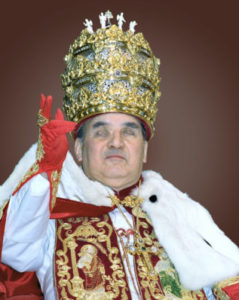
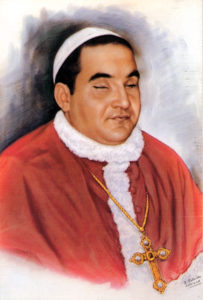
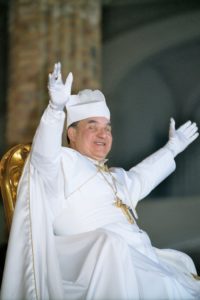
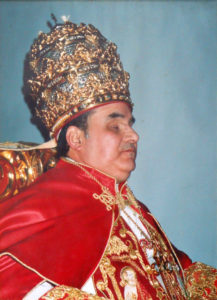








Pope Saint Gregory XVII the Very Great, De Glória Olívæ. (6-8-1978 to 21-3-2005)
Doctor. Most Excellent Reformer of Priestly and Religious Life. Most Zealous and Eminent Restorer of the Holy Sacrifice of the Mass and Reformer of Sacred Rites and of Holy Morals. Most Efficacious Protector of the One, Holy, Catholic, Apostolic and Palmarian Church. Elected directly by Christ. Sublime Mystic. Stigmatic. Spiritual Martyr. Vilely calumniated and betrayed. Totally blind throughout his entire Pontificate. Exalted Founder and Reformer. Patriarch of El Palmar de Troya. Most Zealous Guide and Guardian of the flock. Highly Efficacious Protector of the Palmarian Holy See. Apocalyptic Messenger. Most Illustrious Affluence of Doctrine and Discipline. Intensely Radiant Solar Luminary of the Church.
Pope Saint Gregory XVII, in the world Clemente Domínguez y Gómez, was born in the city of Seville, Spain, on the 23rd of April in the year 1946. He was the son of Raphael and of Saint Maria Luisa, she canonized by her own son. When very small, there were evident signs in Clemente Domínguez of his future glory as Pope. He descended from the tribe of Judah, and also united in his person the noble blood of Spain with the true blood of France. He was ever outstanding for his great love of the Most Holy Virgin Mary and for his devotion to the Holy Face.
The Most Holy Virgin Mary had appeared for the first time in El Palmar de Troya, Seville, Spain, on the 30th of March in the year 1968, in the place of the Lentisco, today inside the Palmarian Cathedral-Basilica where the Holy Face of the Lord and the Image of Our Crowned Mother of Palmar are venerated. Saint Gregory frequently visited El Palmar, though his definitive commitment to this Holy Work was on the 15th of August 1969. The young Clemente Domínguez y Gómez had his first heavenly vision on the 30th of September 1969, in the Place of the Lentisco. From then on he became the chief seer of El Palmar. Heaven lavished itself on him with marvellous apparitions. His ecstasies were of an indescribable grandeur, depth and beauty. The numerous Messages he received were a constant calling from the Lord and the Virgin Mary to prayer and penance, an anxious invitation for all to go to El Palmar, a denunciation of the heresies and progressivism that were assailing the Church without pity.
In his life as a lay person, as chief seer of the Apparitions of El Palmar de Troya, the then Clemente Domínguez y Gómez, still quite young, had to fight valiantly to make known the highly compromising Messages given him by Our Lord Jesus Christ and by the Most Holy Virgin Mary over many years. His loyalty to God was well proven. The young Clemente Domínguez y Gómez had interviews with the highest Prelates of the Roman Church, by then corrupt in their majority, both of Spain and of many other European and American nations. To uphold the rights of God and of the Church as the Lord and the Virgin Mary ordained, he stood up to many of those Hierarchs when faced with their obstinate reactions. On several occasions he visited Cardinal Saint Alfred Ottaviani at his residence in Rome, for him to relay Messages to Pope Saint Paul VI regarding the Church and the Pope’s own Pontificate; in some of those Messages, names and indications of traitor cardinals and bishops were given. On one occasion, in a display of supreme courage, Clemente Domínguez handed over the Messages of El Palmar to Pope Saint Paul VI himself, in a Papal audience. He was tremendously persecuted, even in the Place of Apparitions of El Palmar de Troya itself, by many of those who frequented the Sacred Place, and chiefly to blame were other seers, who cravenly betrayed their own messages and in that way discredited those which Clemente received.
Clemente Domínguez y Gómez, right from the start, became the great Apostle of the Holy Face of Our Lord Jesus Christ and of the Holy Penitential Rosary, devotions highly combated by many, and which he had to defend with courage. On the 2nd of February 1970, by order of Our Lord to Clemente Domínguez, Jesus’ Holy Face, the same portrait that is venerated today, was enthroned in the Sacred Place of the Lentisco in El Palmar de Troya. And on the 12th of September 1972, also by order of Our Lord to the same seer, the Image of the Most Holy Virgin Mary, the one venerated today under the title of Our Crowned Mother of Palmar, was enthroned in the Sacred Place of the Lentisco. Clemente Domínguez y Gómez was the great defender of Pope Saint Paul VI, and revealed to the world with valour and decision that the Pope was victim of Vatican freemasonry, and that the freemasons there gave him powerful drugs to nullify his free will. Clemente Domínguez, still quite young, was given the grace of the Stigmata of the Passion of Christ in his hands, forehead and right side, mysteries which were later repeated on several occasions. He received some of these stigmata in the presence of many of those who frequented the Sacred Place of El Palmar.
On the 23rd of December 1975, the then Clemente Domínguez y Gómez founded the Order of Carmelites of the Holy Face. On the 1st of January 1976, in the Sacred Place of the Lentisco in El Palmar de Troya, he was ordained Priest by Archbishop Saint Peter Martin Ngô-dinh Thuc, and on the 11th of January that same year was consecrated Bishop by the same Prelate, who had come from Rome to accomplish this transcendent mission. After his consecration as Bishop, by order of Heaven, Father Clemente Domínguez ordained and consecrated many others and thus formed the Episcopal College of El Palmar de Troya. All of this was the motive for a tremendous persecution instigated by Archbishop José María Bueno Monreal of Seville, to the point that Clemente spent one night in prison in the Utrera police station together with Father Manuel Alonso Corral. On the following day, the 6th of April 1976, in the morning, the two were taken from the Utrera prison to the Court of first instance, where other Religiosos of the Order awaited them. The judge’s decision was to send the Father Founder, Clemente Domínguez, and Father Manuel Alonso to prison in Seville. The only way out was for all to go abroad. The judge agreed, and set them all at liberty on condition that they were to leave Seville that same day on the way to France. Thus the Father Founder together with seventeen Bishops, eight Presbyters and two lay brothers, were exiled from Spain. They were able to return to Seville at the end of April that same year. Nevertheless, a trial began in the same Utrera Court against Clemente Domínguez, Manuel Alonso and eighteen other Bishops of El Palmar for usurpation of priestly functions, unlawful wearing of religious habits, episcopal consecrations and acts of worship carried out in El Palmar de Troya. On the 11th of April 1977, the Seville High Court ruled that the necessary requirements for the existence of the offences imputed were lacking, and decided that the case be dismissed. Thus the proceedings against the twenty Palmarian Bishops were dropped.
On the 29th of May 1976, on one of his untiring apostolic journeys, Bishop Father Clemente Domínguez lost both eyes in a car accident, an unimaginable suffering for him. Notwithstanding, though blind, he carried on with his apostolate as intensely as before, through Spain, other European nations and America. On the 4th of August 1976, Our Lord Jesus Christ, in one of His wonderful apparitions, promised the primacy of the Church to the then Father Clemente in the following words: “You shall be the future Peter. The Pope who shall consolidate the Faith and integrity in the Church, fighting with mighty strength against heresy, as legions of Angels will assist you… The Great Pope Gregory, the Glory of the Olives.” On the 1st of January 1977, Bishop Father Clemente canonically crowned the Sacred Image which today presides in the camareen of the Lentisco under the title of Our Crowned Mother of Palmar. In later years, he also crowned the image of Most Holy Joseph and that of Saint Teresa of Jesus. On the 20th of January 1977, by order of the Most Holy Virgin Mary, Bishop Father Clemente changed his baptismal name to that of Father Ferdinand. By God’s express wish, and until Pope Saint Paul VI’s death, Bishop Father Ferdinand held the most high dignity of Sub-Vicar of Christ in the Church.
On the 6th of August 1978, Bishop Father Ferdinand being in Santa Fe de Bogotá in Colombia, Pope Saint Paul VI passed away. From that moment, by command of God, he went on to occupy the Throne of Saint Peter with the name Gregory XVII, ‘De Glória Olívæ’. Shortly afterwards, Our Lord Jesus Christ, accompanied by Apostles Saint Peter and Saint Paul, appeared, and placed the Sacred Tiara on the head of the new Pope, who was thus crowned in a mysterious and profound way. Among many other things, the Lord told him: “Only the simple and humble of heart will acknowledge the man who is the true Pope: Pope Gregory XVII. The Great Pontificate of the Glory of the Olives begins. The Pope announced by many mystics, by many prophecies.” He also told him that an antipope would emerge from the conclave in Rome. Present at this great event of the apparition of Our Lord Jesus Christ was the Bishop Secretary of State, Father Isidore Mary, Manuel Alonso in the world, today Pope Saint Peter II the Great. On the 9th of August that same year, the Vicar of Christ, Saint Gregory XVII, arrived by plane at El Palmar de Troya from Colombia, and in this mysterious way the Cathedra of Saint Peter was translated from Rome de El Palmar de Troya, which went on to become the Apostolic See of the true Church: One, Holy, Catholic, Apostolic and Palmarian, also called the Palmarian Christian Church of the Carmelites of the Holy Face. On the 15th of August that same year took place the Solemn Official Coronation of the Palmarian Sovereign Pontiff, namely his external, visible coronation, at the hands of four Bishops who set the Sacred Tiara upon his head. Thus began the history of the Papacy in El Palmar de Troya with the mission of restoring and upholding doctrinal and disciplinary integrity in Christ’s Church, by means of profound reforms and magisterial teachings.
Following the death of Pope Saint Paul VI, the roman church’s general apostasy was consummated and it ceased to be the true Church of Christ. This apostasy drew in its wake the entire Catholic world with the exception of the remnant that held firm in the Church’s true doctrine: the Palmarian faithful under the staff of the true Vicar of Christ Pope Saint Gregory XVII, with See in El Palmar de Troya. In opposition to this truth, a false shepherd was appointed to the apostate roman see: the sinister antipope John Paul I the freemason, wolf in sheep’s clothing, whose motto was ‘De Medietáte Lunæ’ meaning ‘of the half-moon’, symbol of schism and heresy; and following his sham, short-lived pontificate, another false shepherd was appointed: antipope John Paul II the freemason, voracious beast, salient precursor of antichrist, whose motto was ‘De Labóre Solis’, meaning ‘eclipse of the sun’, who was bold enough to interpose between the Sun, Pope Saint Gregory XVII, and mankind, giving rise to the greatest spiritual eclipse hitherto known. Antipope John Paul II was the foremost propagator of heresies and other corruption.
Pope Saint Gregory XVII the Very Great, brandishing his flaming sword, was Exalted Whip against every heresy and other kind of corruption spread throughout the world by sowers of iniquity. This Vicar of Christ vigorously anathematized the apostate roman church’s antipopes and all their followers. This Sovereign Pontiff, as Zealous Guardian of the House of the Lord, kept watch over the door of the fold entrusted to him by Christ, preventing the ferocious wolves from entering to scatter and devour the flock; and at the same time he expelled all those who, camouflaged, sought to corrupt the Church from within. This Great Caudillo of the Tajo, with the canons of his infallible doctrine and his inflexible discipline, proclaimed the Great Crusade of the apocalyptic age by means of a doctrinal and disciplinary, yet militaristic, edict in defence of the rights of God and of the Church; with him began the Caudilloship of the Tajo, and consequently the Carmelite or Cross-bearer Caudilloship of the Last Times.
Pope Saint Gregory XVII went out on numerous Apostolic Journeys: through Europe, America, Asia, Oceania and Africa, preaching everywhere. On one of them, the longest, he visited the Palmarian dioceses of the five continents. On several occasions he was in Jerusalem and other towns of Israel connected with the Life, Passion and other mysteries of Christ and Mary. Pope Saint Gregory XVII was the great Apocalyptic Messenger. Thanks to his Messages, the world has come to know the whole truth regarding these Last Times or Apocalyptic Era. He had the valour and boldness to make known the great events. Thanks to his fidelity to the Messages he received from God, mankind is aware of the content of the Secret Message of Fatima, falsified and betrayed by the reprobate seer, Sister Lucia of Fatima herself, in collusion with the reprobate antipope John Paul II and other high dignitaries of the apostate roman church. Sister Lucia of Fatima betrayed the truth of the Secret Message of Fatima to please high Vatican prelates. The Secret Message of Fatima is fundamentally as follows: communism and freemasonry will scale the highest office and the other chief posts in the Vatican. This was consummated when the antipapacy was established in Rome following Pope Saint Paul VI’s death. Following Sister Lucia of Fatima’s death, Our Lord Jesus Christ appeared to Pope Saint Gregory XVII on the 22nd of February 2005 and gave him the following Message: “The apostate Sister Lucia of Fatima is in the eternal fire of Hell.” Pope Saint Gregory XVII performed the most arduous and transcendent task of giving continuity in the Sacred Place of El Palmar de Troya to the Holy Church founded by Our Lord Jesus Christ. He is the great restorer and reformer of Sacred Rites and of Holy Morals. Thanks to his untiring labour as Sovereign Pontiff and Infallible Master, he exceedingly enriched the doctrinal and disciplinary treasure of the Church and consolidated Faith and Morals. Saint Gregory XVII was a giant Pope. Consequently Pope Saint Peter II the Great gave him the title ‘Very Great’, not granted to any other Pope since Saint Peter.
Prominent among his great pontifical works are: Some fifty Pontifical Documents; a great many Dogmatic Definitions; countless Apostolic Decrees, Letters and Notes; an endless number of Canonizations of illustrious members of Christ’s Mystical Body; numerous apostolic journeys through the five continents; the convocation, solemn opening, presidency, direction, approbation, signing and solemn closure of the Holy Great Dogmatic Palmarian Council; and the convocation, solemn opening, presidency, direction, approbation, signing and solemn closure of the Holy Dogmatic Palmarian Synod. Consequently, the fruits of his most fecund Pontificate were as well the Palmarian Creed, the Treatise on the Mass, the Palmarian Catechism, Palmarian Morals, the Treatise on the Most Blessed Trinity, the Palmarian Code of Canon Law, and above all Sacred History or the Holy Palmarian Bible. He is, par excellence, the Pope of the Holy Bible since, in his gigantic doctrinal labour, he was the first Pope to accomplish an infallible interpretation of Saint Jerome’s Official Bible, called the Vulgate, as well as of the other versions of the Bible, in which the Word of God is mixed up with many errors and adulterations by man. The publication of Sacred History or the Holy Palmarian Bible is an overwhelming triumph for Pope Saint Gregory XVII against the schemes of Satan and his infernal and terrestrial henchman, as in the Holy Palmarian Bible the Word of God is contained in its absolute authenticity and purity; and therefore now free of the errors and adulterations that considerably contaminated and obscured it. Pope Saint Gregory XVII, as Universal Doctor, masterfully taught: “The Bible has authority under the infallible interpretation of the Magisterium of the Church.”
Pope Saint Gregory XVII was fiercely combated as well by the majority of his fellow Sevillians, who treated him as a lunatic, an impostor, a heretic, a schismatic, a swindler, a money-grubber and other like epithets. Without any doubt this sprang in great part from the raging envy they felt at the greatness of his achievements. In Seville, his beloved native city, he was considered a sinister personage. One day Sevillians will regret not having recognized Saint Gregory XVII in time, one of the greatest Popes in the History of the Church. When they finally realize, they will not have enough handkerchiefs to wipe away their tears, and will go to El Palmar to devour the stones of the Sacred Place, Apostolic See of the Church, where the greatest Heavenly Apparitions have taken place, which in their stubbornness they likewise disdained to acknowledge. Once again are fulfilled Our Lord’s words: “Truly, I tell you, no prophet is accepted or honoured in his hometown.”
Pope Saint Gregory XVII was favoured with great visions and messages from the beginnings of El Palmar. He was a mystic of the highest order. His visions were countless, since Our Lord Jesus Christ and the Most Holy Virgin Mary appeared to him with very great frequency. His visions of the Eternal Father, of the Holy Spirit, of Saint Joseph and of a great number of Saints were also numerous. By way of his sublime ecstasies he penetrated into great mysteries, many made known and others reserved to himself. He was often rapt up in the contemplation of the Divine Essence. He also enjoyed the gift of penetrating into the depths of souls, of which he gave many unmistakable proofs. His messages are very numerous, of very varied content, of illustrious wisdom and doctrinal richness. With great frequency he received heavenly locutions regarding many matters concerning Holy Church, the Order and other questions. He was one of the most outstanding prophets in the History of the Church.
Though the Apostolic See of the Palmarian Church is the Sacred Place of El Palmar de Troya, nonetheless Pope Saint Gregory XVII resided in Seville until the 24th of July in the year 2003, date on which he went to live in “Finca de Nuestra Madre del Palmar Coronada”, where the Palmarian Cathedral-Basilica is situated, in the village of El Palmar de Troya, Utrera in the province of Seville.
Glorious Pope Saint Gregory XVII the Very Great passed away at 3.30 pm on the 21st of March in the year 2005, Holy Monday, in his cell in the Papal Residence in “Finca de Nuestra Madre del Palmar Coronada”, El Palmar de Troya. Glorious Pope Saint Gregory XVII the Very Great, though he died on the 21st of March in the year 2005, nonetheless sublimely consummated his most fecund life while celebrating the Holy Sacrifice of Mass the previous day, the 20th of March, on the High Altar of the Cathedral-Basilica of Our Crowned Mother of Palmar; for while at that Sacred Altar he became grievously ill, and in this way was mystically crucified on the Cross of Calvary, since Holy Mass is the same Sacrifice of Calvary or Sacrifice of the Cross. This is the supreme aspiration which every Minister of the Lord should have; and consequently the greatest honour a Priest can have. Pope Saint Gregory XVII was solemnly canonized by his Successor Pope Peter II on the 24th of March in the year 2005, Festivity of Holy Thursday. Declared Very Great Doctor of the Church by Pope Saint Peter II the Great on the 23rd of April 2005. On the 29th of July 2005, Pope Saint Peter II the Great infallibly defined that the soul of Pope Saint Gregory XVII the Very Great, ‘De Glória Olívæ’, did not pass through Purgatory, but went straight to Heaven.
Pope Saint Peter II the Great
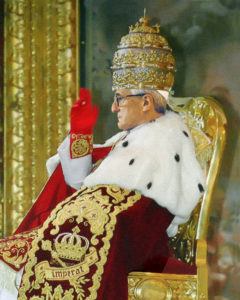
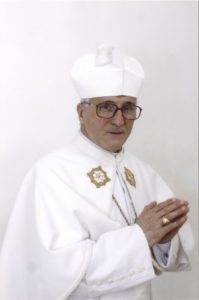
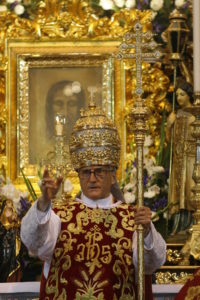
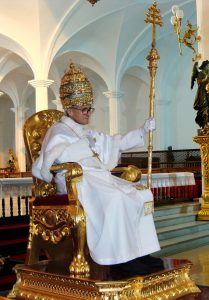
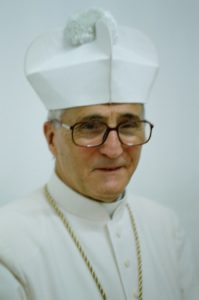
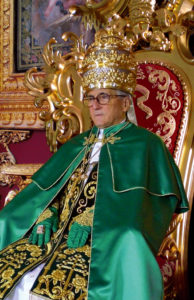
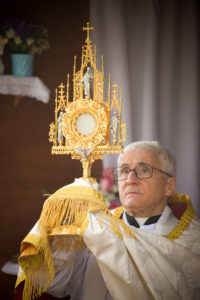








Pope Saint Peter II the Great, De Cruce Apocalýptica. (21-3-2005 to 15-7-2011)
Great Doctor, vilely calumniated and betrayed, Cofounder of the Order of Carmelites of the Holy Face, Patriarch of El Palmar de Troya, Second principal column of the Church of Christ in the spiritual desert of El Palmar de Troya, Protector and Defender of the Holy Palmarian Christian Church, Magnanimous Collaborator in Palmarian Doctrine and Discipline, Aflame with the zeal of Elias, Pre-eminent Solar Luminary of the Church.
Called Manuel Alonso Corral in the world, he was born in Cabeza del Buey, Badajoz, Spain, at six in the morning on Thursday 22nd of November 1934, feastday of Saint Cecilia, virgin and martyr; so that he was given the second Christian name of Cecil. A few days later he was baptized in the Parish Church.
His father, Joseph Alonso Píriz, a native of Zamora, was a State Schoolmaster by profession. Deeply Catholic, he was faithful to the political ideals of the National Movement. His mother, Juliana Corral García, a fervent Catholic, canonized by her son Pope Saint Peter II on the 8th of May 2011, was born in a town called Alhocén, in Guadalajara, though her parents were from El Vellón, Madrid, where they resided. Manuel’s parents met and married while his father was a schoolmaster in this last town, until later transferred to Cabeza del Buey. They had seven children, five boys and two girls, Manuel being the fourth child.
During his early childhood it was his lot to live, in his native town, the Glorious Spanish Civil War, in the red zone, until shortly before the end of the hostilities. There, in Cabeza del Buey, it fell to him to suffer the misfortunes and trials of the conflict Spain was undergoing. His father, known as a Catholic schoolmaster ever loyal to the cause of Saint Francisco Franco, was the object of persecution by the town communists, without his firmness weakening on that account; and though his life was at risk, with inexpressible heroism he ever rejected any favourable offer which might have involved betraying his holy religious and political ideals. The family had to bear with bombardments, refuges, flights into the country, until his father performed the valorous and unforgettable feat of passing over with his wife and three young children from the red zone to the National zone, making their way between the two fronts until reaching the city of Zamora, where relatives of his lived.
Once the war had ended in 1939, Manuel being five years old, the family moved from Zamora to El Vellón, Madrid, where his mother’s sisters lived with Jesus, his next elder brother. Shortly afterwards they returned to Cabeza del Buey, until his father was appointed teacher in El Vellón, where Manuel made his First Holy Communion. From there, in the year 1944, at some nine years of age, he went to live in Madrid, where his father definitively practised his profession.
Madrid was the city in which he grew up, and which he loved so deeply that he considered himself a Madrileño at heart, as much or more so than if he had been born there, being deeply imbued with its beautiful and colourful customs, its pious traditions and its entire cultural, political and historical personality.
His first formal schooling in Madrid was at the Vázquez de Mella School. At eleven years of age he passed the entrance exam to study at San Isidro’s College for his school leaving certificate. There he did the seven years of the then Bachillerato Superior. He passed his final exam in the old Central University building, obtaining the certificate of Bachiller Superior on the 12th of July 1954. In October that same year, he began to study Law, as an external student, as sickness prevented him from always attending class.
It is well to mention that his pious parents took pains to give, both to him and to all their other children, a solid religious formation, as they practised their religion with the most conscientious scrupulosity and submission to Holy Mother Church. He did not remember them ever saying one word which might have offended or been injurious to any Priest. With admirable zeal, his parents, even when their children had grown into youths, made sure to take them to Mass, to confession and to Holy Communion, at least on Sundays, Holydays and First Fridays of the month.
Thanks be to God, during his childhood and youth, though with the normal ups and downs, he led a life of piety and apostolate within the parish catechesis and the ranks of Catholic Action, with all his heart helping his two elder brothers, Joseph and Jesus, who held posts. His brother Saint Joseph Alonso Corral became Youth President. Manuel’s youth in Madrid was very happy, since despite the family’s many sufferings owing to serious illnesses, he was full of enthusiasm, especially for his studies, literature, and art. His father often took them to concerts, classical theatre performances, the El Prado museum and many other cultural centres. Nonetheless, his greatest aspirations were focused on one day entering the religious life. How much was he to suffer on that account! For he always found his desires of entering some monastery frustrated owing to his very precarious health. For this reason he was heartbroken for many years. Nonetheless, inwardly he always clung to that hope, which was later realized in El Palmar de Troya, Seville, Spain. The age of eighteen was crucial for him, as he came to be more aware of the realities of the spiritual life, and gave himself up fully to religious practices, coming to attain a deep love of purity. In the Church of ‘San Pedro el Real’ in Madrid, popularly known as the Church of La Paloma, he met an elderly lady called Mary Valiente López. He learnt important things about the spiritual life from her; above all, devotion to Our Mother of Perpetual Succour, from which he was to receive so many favours. When Pope, he was to canonize her on the 21st of June 2009.
From eighteen years of age, he began to have contact with the Redemptorist Fathers, and he was filled with enthusiasm at the rural missionary spirit of this Religious Order, and with the deep devotion they professed to the Most Holy Virgin Mary under the title of Our Mother of Perpetual Succour. He felt so drawn to their piety that he took one of those Friars as spiritual director. His devotion to the Most Holy Virgin Mary began to turn almost into delirium, as not for one moment could he cease to think of Her. He wanted to be sure of Her protection. To do so, at eighteen years of age, on the 25th of July, Feast of Apostle Saint James, he made a solemn vow of Marian Slavery before the Perpetual Succour picture; a vow he renewed every year from then on until his death. He felt deeply protected by the Virgin, and placed all his hope in Her. But Marian devotion was not limited to a mere outburst of fervour, as it infused great love for the Eucharist in him, and he made every effort not to lose Holy Mass and Communion one single day, and moreover to pray the Holy Rosary. At that time, he was very ill with lung trouble, with little hope of a swift recovery, for whenever he made some effort proper to the ordinary life, he relapsed and had to take to bed. Every year he went with great fervour to the novena held by the Redemptorists to Our Mother of Perpetual Succour. As he suffered greatly from his illness, he used to ask the Most Holy Virgin for his cure. At the end of the year 1955, he began to feel a certain conviction that, in the following novena to Our Mother of Perpetual Succour, She would cure him completely, a conviction which deepened every time he looked at the Perpetual Succour picture. On the 7th of February 1956, his saintly brother Joseph died, to his and the whole family’s great grief. In the following month of May, he attended the novena to the Virgin as usual, and from then on never again had lung trouble. The doctors who later saw him were amazed to see how well he had healed.
Some months after his brother’s death, in the year 1956, when twenty-one years of age, as he found himself in good health, he began to work at the Nuclear Energy Board, thanks to a cousin of his who had a job there as a mining engineer. It was a great joy for him to be able to earn his living and at the same time continue his Law studies, to which he felt singularly drawn. It cost him great efforts and almost heroic sacrifice to continue with his studies: because of his work he had to rise up very early every morning so as not to lose Holy Mass and Communion, since his workday began at eight in the morning and finished at six in the evening, with a short break for a meal. Once over, he stayed on at his office to study until very late, then returning home. He suffered greatly from lack of sleep; since he scarcely had time to rest, and besides had trouble falling asleep.
His concern to receive Holy Communion daily led him very often to make great sacrifices; and God’s action was frequently noted, so that he might not be deprived of that supernatural nourishment. It was quite usual for him to rush through Madrid’s streets in all haste, going from church to church, looking for one where he could receive Holy Communion, taking advantage of the breaks between classes when attending the university in the evening. He rarely missed Holy Communion, as he sought It every day so earnestly.
He obtained his degree in Law in June of 1963. This was a great joy for him, as it had cost him many privations; for while others, after their work in the office, went out to enjoy themselves, or at least to relax, he had stayed on inside studying for long hours. In the year 1964, the Nuclear Energy Board granted him a scholarship to do Management Studies. The new course likewise meant great sacrifices for him. For once his work at the Board ended, he had to attend class from seven in the evening until ten at night, and then at home settle down to study. If previously he slept little, he now slept less. But these studies allowed him greater facility for fulfilling his religious duties; since in the Jesuit college where he was doing this course, there was naturally a chapel, where it was easy for him to hear Mass and communicate. The course on business studies lasted three years and, thanks be to God, he came through the exams each time with excellent marks; above all the last, despite having spent one month ill in bed with hepatitis and another month convalescing. In June of 1967, the studies ended, with the corresponding Degree.
He combined his work and study with the apostolate of Catholic Action. He also used to visit hospitals on Sundays, instructing and consoling the sick. Until twenty-eight years of age, his apostolic life was very intense, as he devoted all his free time to it. On one occasion he did the Spiritual Exercises of Saint Ignatius with the Jesuits, living in, and he was assured that he was of no use at all for the religious life; nonetheless, those exercises were very beneficial to him and a great experience. He also took part in short courses on Christianity, thus strengthening his spirituality, which was beginning to wane. Yet as from twenty-eight years of age, when he had more contact with the world, he found himself being dragged along by his human weaknesses, until then almost dormant in him, with the resultant constant struggle of falling and rising up; since despite his many falls, he never wholly gave up, as he confessed and communicated very often. They were years of great interior suffering, indescribable desolation and almost despair. Still, in the midst of this black whirlpool, in a dream he was given to know that the Most Holy Virgin Mary would help him to overcome Satan, with a new resurgence of his spiritual life; which was later to be fulfilled in El Palmar de Troya. In the dream, he saw an enormous shadow hurling him over a tremendous precipice, and saw that someone held him back and freed him from falling into the abyss.
He was always deeply enamoured of literature and the arts. From an early age, as has been said, his father instilled in him, as in the other children, love for good books, paintings and other forms of culture not opposed to the Law of God. His mother had less free time for this, owing to her many duties at home; though she also shared her husband’s interests. Every work of literature fascinated Manuel; above all poetry. From his youth he read the Spanish classics: Saint Teresa of Jesus, Saint John of the Cross, Cervantes, Lope de Vega, Tirso de Molina, Saint Peter Calderón de la Barca, and so forth… And likewise the luminaries of romanticism, contemporary writers, and so on. He eventually wrote a good number of poems, and won first prize for one in a poetry competition; though when he became a religioso he burnt all his writings.
Towards the end of 1966, in Madrid, when he was still doing Business Studies, through a friend he met the superior of the Saint John of God Brothers, who lived in the sanatorium house of Our Father Jesus of Great Power in Seville. Without Manuel having made him any proposal, the superior offered him a post in the Insurance Company and the Workshops of this Institute, so that he might organize the administration and the accounts. Manuel told him that he agreed, but that beforehand he had to obtain his second Degree. It pleased him deeply to go and live in Seville, a city which he had recently visited twice, and whose extraordinary beauty had seduced him. His degree obtained, he asked for leave from the Nuclear Energy Board and they granted him one year.
On the 15th of January 1968, he arrived in Seville by car, accompanied by his mother and a brother. He was received with great affection and consideration by the superior of the Saint John of God Brothers. He began his work checking over all the money being deposited in the Spanish banks and savings institutions on the occasion of the great campaign which the superior was carrying out for the construction of the Saint John of God City in the province of Seville. Afterwards, he devoted himself to watching over and organizing the Insurance Company of Saint Raphael and Saint John of God, which had fallen into complete chaos; and with much work and prudence, he was able to set it to rights. He felt very happy working at this task. He was well liked and regarded by all, religiosos, children and workers. He laboured with great enthusiasm; especially because he was dealing with a Catholic Social undertaking. He took no account of sacrifices made and enjoyed the great confidence of the superior and of the other religiosos.
His coming to Seville, a very beautiful provincial capital, was shortly afterwards linked to one of the most transcendent events in history: the Apparitions of the Most Holy Virgin Mary in El Palmar de Troya, and Manuel’s association with the principal seer, Clemente Domínguez y Gómez.
On the 30th of March 1968, the Most Holy Virgin of Carmel appeared for the first time over a lentisk-tree (lentisco) in the La Alcaparrosa property, to four girls from the village: Raphaela, Ana, Josepha and Ana. This shrub called lentisk was plentiful on the property. Nothing remains of the lentisk tree of the first apparition, since the devotees used to cut its branches off as precious relics. A small wooden Cross was set up in the exact Place, and around it prayers were recited and the seers received heavenly visits. Later on, Clemente by then a seer, the Sacred Face of Jesus and the Imagen of Our Mother of Palmar were set up in this place of the Lentisco. In this way the spot chosen by the Most Holy Virgin in Her first apparition was preserved. After the first four girls, other seers arose: Rosario Arenillas, from El Palmar de Troya, on the 14th of April 1968; Maria Marín, from Utrera, on the 20th of May 1968, and Maria Luisa Vila, from Seville, on the 6th of June 1968. And in that same year: Antonio Romero, José Navarro (Cayetano), Manuel Fernández, Antonio Anillos and others, all residents of El Palmar de Troya. Subsequently Arsenia Llanos, from Jerez de la Frontera, was also chosen as a seeress. Sadly, all those seers later betrayed the Work of El Palmar, and abandoned this Sacred Place of Apparitions, for varied reasons.
Manuel met Clemente in Seville on the 18th of May 1968; and it was at the precise moment determined by Providence to be able to know, follow and share the stages Clemente was to live through as a seer. As from his meeting with Clemente, their friendship grew daily closer and more sincere. Clemente had been born in this city of Seville, in a house quite close to the present apostate roman cathedral, on the 23rd of April 1946. He worked in an office as an accountant and lived quite simply. In the first days of their friendship, following a conversation they had together, Clemente revealed that in the space of a week he had had two dreams: the Most Holy Virgin had appeared to him and had vested him in the habit of Saint Dominic. Clemente told him all this in a very natural way. Manuel gave it little importance. But he, sure of the transcendence of the dreams, emphatically reaffirmed: I will be a Dominican.
When he met Clemente, Manuel had already visited the place of Apparitions out of mere curiosity, though with some respect and interest. He spoke of El Palmar to Clemente, who had also already visited it, and they travelled out to the Place of Apparitions in Manuel’s car. During the different visits they made in the year 1968, their attitude was one of respectful curiosity, for at heart they admitted that something supernatural might be taking place.
It was the 15th of October 1968. They learnt that the Most Holy Virgin, through Maria Marín, had called for many to come that day to El Palmar. He and Clemente went to El Palmar at night. When they arrived everything was over, as it was almost 11 at night. Nonetheless, something unpleasant awaited them at that hour. On reaching the entrance to the property, they observed that a number of people were still at the Lentisco. They were moving around as though dancing in a circle about a woman, while singing the Hail Marys of the Rosary, interspersed with sarcastic outbursts of laughter, guffaws and diabolic applause. The blood-curdling spectacle could be discerned at that distance thanks to some lighted candles there. They did not dare to go up to the Lentisco. They prayed some Hail Marys and went back to Seville. Some time later they were informed that a deranged woman, whom nobody knew, had sown confusion among those present by saying that she was the incarnation of the Virgin of the Pillar. From that day, he and Clemente practically ceased to visit El Palmar.
However, early in the summer of 1969, thanks to an article published in the ABC newspaper by a Jesuit Father in defence of El Palmar, they again felt an interest in those supernatural phenomena. A key date was the 15th of August 1969, Festivity of the Assumption of the Virgin. In the morning he and Clemente left to spend the day at the beach in Cadiz. But on the way they decided to make a stopover in El Palmar de Troya. A group of people were there, awaiting a Jesuit Father, who might possibly say Mass in the afternoon. Shortly afterwards this Priest arrived. They spoke with him and decided to spend the whole day there.
More pilgrims resorted there in the afternoon. The Jesuit Father said Holy Mass on an altar beside the boundary wall, outside the Apparitions site.
During Mass, Maria Luisa Vila had a vision of the Most Holy Virgin. It was the first time they had been present at an ecstasy, though they were not very close to the seeress. They received Holy Communion with much devotion and became convinced that the Apparitions of El Palmar were true. They then went up to the Lentisco, where Maria Marín, in a marvellous ecstasy, was seeing the Lord. Suddenly they heard a powerful voice that said with assurance: “Christ is present here!” Their whole being trembled. It was the first time that they had heard that the Lord was appearing in El Palmar. They also witnessed a vision of Rosario Arenillas, and noted a heady heavenly fragrance. From then on their visits to El Palmar were almost daily. They came to know the seers better, and had proofs of their authenticity.
Very significant were the frequent attentions which the Lord and the Most Holy Virgin gave to Clemente through the different seers of El Palmar, setting him out in singular fashion and showing special preference for him. Doubtlessly, Heaven was preparing the way for the one to whom Their most important Messages would later be confided.
An unforgettable day for them was the 14th of September 1969, Feast of the Exaltation of the Holy Cross. It was already night. Shortly before, they had witnessed an ecstasy of Maria Luisa Vila, which had filled them with great peace. But the Devil, making use of someone present there, disturbed Manuel’s soul, filling him with doubts. He and Clemente went down to the road. Anguished confusion, seizing hold of Manuel’s mind, made him exclaim: “I shall not come back to El Palmar as long as the Virgin does not call me!” Clemente wept. Of a sudden, a most powerful light came up from the horizon, slowly advancing until resting over the Lentisco, forming a great Cross upon a pedestal of luminous flowers with a wonderful radiance. The emotion was indescribable. He and Clemente went running back towards the Lentisco. But half way up, the marvellous vision disappeared. They asked three people praying there if they had seen anything. They looked at them in surprise, answering negatively. The seer José (Cayetano) was also there, and he confirmed their vision, and presently entered into a marvellous ecstasy.
They continued to frequent El Palmar. It was on the 30th of September 1969, when Clemente had his first vision. One year and a half had transpired from the first Apparition in El Palmar. A good number of people were praying in the Lentisco, among them the seeress Rosario Arenillas. It was nightfall. Suddenly they noted a kind of sigh from Clemente, who told them that he was seeing the figures of two people, one tall and the other shorter, walking slowly towards the Lentisco from the upper part of the property. The two figures, which were dark, whose facial features the seer was unable to discern, stopped some metres away from the Lentisco. Clemente, at the same time as he saw them, was conscious of the place and of the people around him. He understood from the details, somewhat hazy, of their bodies, that they were the Lord and Padre Pio. The vision over, the seeress Rosario Arenillas, who had also witnessed the apparition, confirmed that they were the Lord and Padre Pio. A few days later, he had an identical vision, and in the same circumstances, with the seeress Maria Luisa Vila.
From this time on, Clemente had visions frequently. He also saw the Virgin, Saint Joseph and other Saints, but in the same way as the first two visions: dark and unable to make out their faces. The 8th of December 1969, Festivity of the Immaculate Conception, was a memorable day for Clemente. In the morning they went to El Palmar to stay there the whole day. A good number of people met up there. Towards mid-morning, Clemente entered into ecstasy at the vision of the Immaculate Virgin. Minutes later, the Lord appeared as Christ the King. It was the first time that the seer had seen the Lord and the Virgin clearly. He saw all the details of their figures and faces perfectly. Clemente fell to the ground in rapture, with the loss of all his senses. From that day on, in all of Clemente’s visions, he had perfectly clear perception. But in the evening, by then dark, Heaven regaled him with further wonderful visions. First the Most Holy Virgin appeared, surrounded by Angels who bore the Habits of the Order of Saint Dominic. Shortly afterwards the Lord appeared, and later a Saint. The Lord indicated to the seer that it was Saint Dominic. This Holy Founder of the Dominicans announced to Clemente the presence of Saint Joseph, who also became visible. For the first time the seer heard the voices of the Lord, of the Virgin and of the two Saints. His vision, however, became ever more impressive. Clemente received the Habit of Saint Dominic from the hands of the Most Holy Virgin. The Angels brought it and vested him with it. Shortly afterwards he also received the sacred vestments of a Priest, and recited the parts of the Mass in Latin, dictated to him by Saint Joseph, except for the Consecration. All this happened mystically, since the seer saw himself thus vested in the vision. Those who surrounded the seer only perceived his gestures and heard his voice. This ecstasy was indescribably beautiful and touching.
Clemente received his first Message from the lips of Saint Dominic on the 10th of December 1969, recommending the recital of the Holy Rosary of the Our Fathers. Something very significant, however, took place that day. When they reached El Palmar, the entrance to the property, which was beside the large Cross in the surrounding wall, was closed. That was the primitive entrance. They settled down to pray close to where the Imagen of the Divine Shepherdess was later enthroned. Clemente fell into ecstasy. He saw that Saint Joseph had moved down from the Lentisco to the wall, close to them. The Lord and Saint Dominic also appeared. When the ecstasy ended, they could see that a new entrance had been opened up, which exists today. They could not overcome their surprise, as no one had heard the least noise. Only Don Antonio Vota told them that during Clemente’s ecstasy, he went to place his hand upon the wall and it fell down. Rather strange, as the wall was sufficiently strong not to fall so easily. Clemente remarked that Saint Joseph had stood on the wall right at the new entrance. They all understood that it was this Saint who had opened it. They did not dare to enter. At last they went inside the property with certain trepidation and, when they had taken some steps, Clemente saw Saint Joseph who, from the entrance, with his staff, indicated that they should go up to the Lentisco.
On the 12th of December 1969, Clemente had a vision of Saint Dominic, who told him: “See now at my right hand the Divine Countenance of Our Lord Jesus Christ. See, my son, the Face of Him who gave all, to His very breath, for your sins and for the sins of the whole world.” And the Holy Face of Jesus appeared, dolorous and bleeding. Saint Dominic then gave him the important Messages on the Holy Face: the spreading of the Holy Face throughout the world, the Holy Viacrucis and the Reparatory Communion of the First Thursdays, making reparation for the outrages done to the Lord’s Divine Countenance.
Until the Holy Face was set up in the Lentisco, they used to bring up a picture of the Lord’s Face, before which they said the prayers. The Holy Face of the Lentisco was set up, by order of Heaven to Clemente, on the 2nd of February 1970. The Image of the Divine Shepherdess was emplaced and blessed on the 1st and 2nd of March 1972. Our Mother of Palmar was placed in the Lentisco on the 12th of September 1972.
In Manuel’s professional work at the Saint John of God Institute, because of his association with the Apparitions of El Palmar de Troya, his prestige crumbled. The religiosos considered that his work at the Institute was incompatible with the Apparitions, in which he firmly believed. He never neglected his professional duties; so the only reason for that incompatibility was that the Apparitions of El Palmar, following their condemnation by the apostate cardinal of Seville, Bueno Monreal, might compromise the Saint John of God Institute. Nonetheless, both the cowardly and unjust superior of those religiosos, as likewise the other religiosos, were well aware of his honesty, professionalism and Catholic integrity, since besides, in the Apparitions they were taught to be true Christians. However, their fear and cowardice in the face of what others might say led them to betray their own consciences, acting unjustly and dismissing him.
Manuel Alonso was the great propagator of the Palmarian Messages given to Clemente Domínguez, and accompanied him on many of his apostolic journeys throughout the world. They both lost their jobs unfairly on account of their valiant defence of the Work of El Palmar. And God permitted this so that from then on they might dedicate themselves entirely to the apostolate. In different Heavenly Messages, the Lord, the Virgin and other Saints, showed their love for Manuel, addressing him words of gratitude and praise through the seer. Though he was not himself a seer, on certain occasions, both as a layman and as Bishop, he had personal charisms which strengthened him further, if possible, in the truth of El Palmar.
The Divine Work of El Palmar de Troya was fiercely persecuted by the progressivist and ruinous hierarchy of the Roman Church, then ruled by glorious Pope Saint Paul VI, Martyr of the Vatican, who was aware of the Apparitions and Messages of El Palmar, handed over to him by the seer himself. Saint Paul VI never condemned the Work of El Palmar de Troya. Clemente Domínguez and Manuel Alonso had to defend the Apparitions of El Palmar with vigour and tenacity. On the 23rd of December 1975, despite many obstacles, Clemente Domínguez y Gómez, by order of Our Lord Jesus Christ, founded the Religious Order “Carmelites of the Holy Face in Company of Jesus and Mary”, of which Manuel Alonso Corral is Cofounder. On the 1st of January 1976, at the request of the Most Holy Virgin, Clemente Domínguez and Manuel Alonso were ordained Priests by Archbishop Saint Peter Martin Ngô-dinh Thuc, who had arrived from Rome some days previously. And on the 11th of January 1976, they were both consecrated Bishops.
On the 29th of May 1976, owing to a car accident brought about by Satan, Bishop Father Clemente lost both eyes. Several months later, by order of Heaven, Bishop Father Clemente received the name of Father Ferdinand, and Bishop Father Manuel Alonso received the name of Father Isidore. The Order of Carmelites of the Holy Face grew, and a sizeable episcopal college was formed.
In the city of Santa Fe de Bogotá, capital of Colombia, at the death of Pope Saint Paul VI on the 6th of August 1978, Bishop Father Ferdinand, Clemente Domínguez y Gómez in the world, was elected, anointed and crowned Pope directly by Our Lord Jesus Christ. Three days later, the new Pope, called Gregory XVII, De Glória Olívæ, translated the See of the Church from Rome to El Palmar de Troya, Seville, Spain. Thus began the history of the Papacy in El Palmar de Troya, with the mission of restoring and maintaining doctrinal and disciplinary integrity in Christ’s Church, by way of profound reforms and magisterial teachings. For this purpose, Pope Saint Gregory XVII the Very Great convoked the Holy, Great, Dogmatic Palmarian Council and the Holy Dogmatic Palmarian Synod, in which the then Most Reverend Father Isidore Mary, Secretary of State, took part as principal collaborator. The great Reform Work reached its peak with the elaboration and publication of the Holy Palmarian Bible.
Most Reverend Father Isidore Mary, by order of Pope Saint Gregory XVII the Very Great, travelled through different parts of the world preaching and teaching the true Palmarian Catholic doctrine. On the 24th of October in the year 2000, Pope Saint Gregory XVII the Very Great drew up and signed an Apostolic Decree, naming his Secretary of State, Bishop Father Isidore Mary, as his successor in the Cathedra of Saint Peter. Immediately after the death of Pope Saint Gregory XVII on the 21st of March 2005, in El Palmar de Troya, the new Pope began his Pontificate with the name of Peter II, De Cruce Apocalýptica. On the 24th of March, Holy Thursday, his official coronation took place in the Cathedral-Basilica of Our Crowned Mother of Palmar in El Palmar de Troya, with the assistance of all the Palmarian Bishops, the other members of our Religious Order and of a large number of terciario faithful of the Holy Palmarian Church. That same day, the 24th of March, Pope Saint Peter II the Great canonized his revered predecessor Pope Gregory XVII the Very Great.
The Papacy of the Glorious Vicar of Christ, Peter II, lasted six years, three months and twenty-four days. He was a Pope of great works in the Church’s interests, as he drew up and approved the magnum opus of Palmarian Ecclesiastical History, as likewise the Palmarian Lives of the Saints, the Children’s Grade Bible, and the Elementary and Intermediate Grade Bibles. He also revised and rearranged the Messages of El Palmar de Troya. Warranting special mention among his writings are his Thirty Apostolic Letters sent out to the Church to teach, correct and hearten his Flock, which he loved so dearly as great Shepherd. He declared the Holy Years 2008, 2010 and 2011. He solemnly consecrated the Church Militant to the Eternal Father on the 21st of March 2008. As likewise he solemnly consecrated the Church, Spain, the World and the entire Universe to the Holy Face of Our Lord Jesus Christ on the 30th of March 2010. He also brought up to date, revised and retouched different doctrinal texts. A great number of outstanding members of Christ’s Mystical Body were raised to the rank of the Glory of the Altars and declared Doctors of the Church by him. Likewise, on the 23rd of July 2006, he infallibly defined that he was descended on his father’s side from Saint Ferdinand III, king of Castile and León, and his first wife Saint Beatrice of Swabia; and on his mother’s side from Saint Alphonse Sánchez de Cepeda and his second wife Saint Beatrice de Ahumada, parents of the exalted Reformatrix of Carmel, Saint Teresa of Jesus. He also dogmatically defined other doctrinal matters.
As Pope he had a great interest in visiting and celebrating Holy Masses in different cities and countries marked by his Sacred Footsteps, and thus be able to make the word of God fructify, in imitation of the first Pope Saint Peter I the Very Great. And so, following this yearning, being the first Pope known to have done so, he celebrated Holy Mass in Russia, on the 27th and 28th of May 2008 in Saint Petersburg, and on the 29th, 30th and 31st of May 2008 in Moscow. In Moscow he consecrated Russia to the Holy Face, to Our Crowned Mother of Palmar and to Most Holy Crowned Saint Joseph of Palmar, to implore the Eternal Father for the swift conversion of the Russian people.
His health began to deteriorate alarmingly from the start of the year 2009, with kidney problems, which he had been having for some time. He had to undergo several operations. In one of them, which lasted five hours, cancer of the ureter was detected, and it was decided to remove it and extirpate the right kidney, which no longer functioned, being atrophied. From then on his problems became increasingly complex. A highly malignant tumour was detected, and despite all the tests and treatments he underwent, the cancer continued to develop. His will to recover, subordinated to God’s Will, to be able to serve and work for the Church, made him suffer intensely, as he was always conscious of the gravity of his condition, finding himself ever more in need of assistance. With every passing day he felt a little worse. Disease undermined his whole strength. The doctors attending him did not know what to say at all his bodily suffering. They couldn’t understand how he kept alive.
Countless were the medicines and treatments he had to receive from Holy Week 2011 up till the day of his death. It was painful in extreme to see the Father General of the Church ebb away, to see him lose his speech, smile, gaze and encouragement. During the last days of his life, he was scarcely able to receive food and drink, and every attempt to that end resulted almost fruitless.
His illness had great ups and downs, so that it was always thought that he was in his last moments. He had repeatedly made known that, for the great devotion he had to Saint Teresa, he thought that the day of his death would be the 15th of some month, since the feastday of the Holy Reformatrix was also on a 15th. Close to the 29th of June, feast of Saint Peter I the Very Great, it was thought that he would be unlikely to reach it.
Days later his breathing became alarmingly difficult, so before the Community of Friars went out to evening worship at the start of Vespers preceding the Feast of the 16th of July, all the Friars went to the Papal Cell in order to take their leave of the Holy Father, and each give him their Blessing, as he was very grave. This was the Holy Father’s desire, which was fulfilled, for he had always wanted to bid farewell to all before dying, in spite of him then being unconscious. Some hours later he died in the Papal apartment in the monastery of the Carmelites of the Holy Face in the Sacred Place of El Palmar de Troya, at 20.07 on the 15th of July 2011, eve of the festivity of the 16th of July, while at the Main Altar of the Cathedral-Basilica, the daily Eucharistic Procession worship almost over, the Salve Regina was being sung during the final incensation of the Altar. Once prepared for burial in Papal adornments and white-coloured Pontifical vestments, he was borne to the Sanctuary of the Main Altar of the Cathedral-Basilica of Our Crowned Mother of Palmar, where he was given homage with a great show of filial love from Friars, Nuns, and the Palmarian faithful who had come on pilgrimage for the 16th of July. Turns of Holy Masses were celebrated throughout the night and following day, with the recital of the pilgrimage prayers.
On the 16th of July 2011, at 12 midday, he was declared Venerable Servant of God.
Pope Saint Peter II the Great was solemnly canonized on the 17th of July in the year 2011. In the Act of his canonization, Pope Saint Peter II was declared “the Great”, and was named “Protector and Defender of the Holy Palmarian Christian Church”.
He was declared Great Doctor of the Church on the 26th of July in the year 2011, festivity in honour of Saint Anne, Mother of the Most Holy Virgin Mary.
